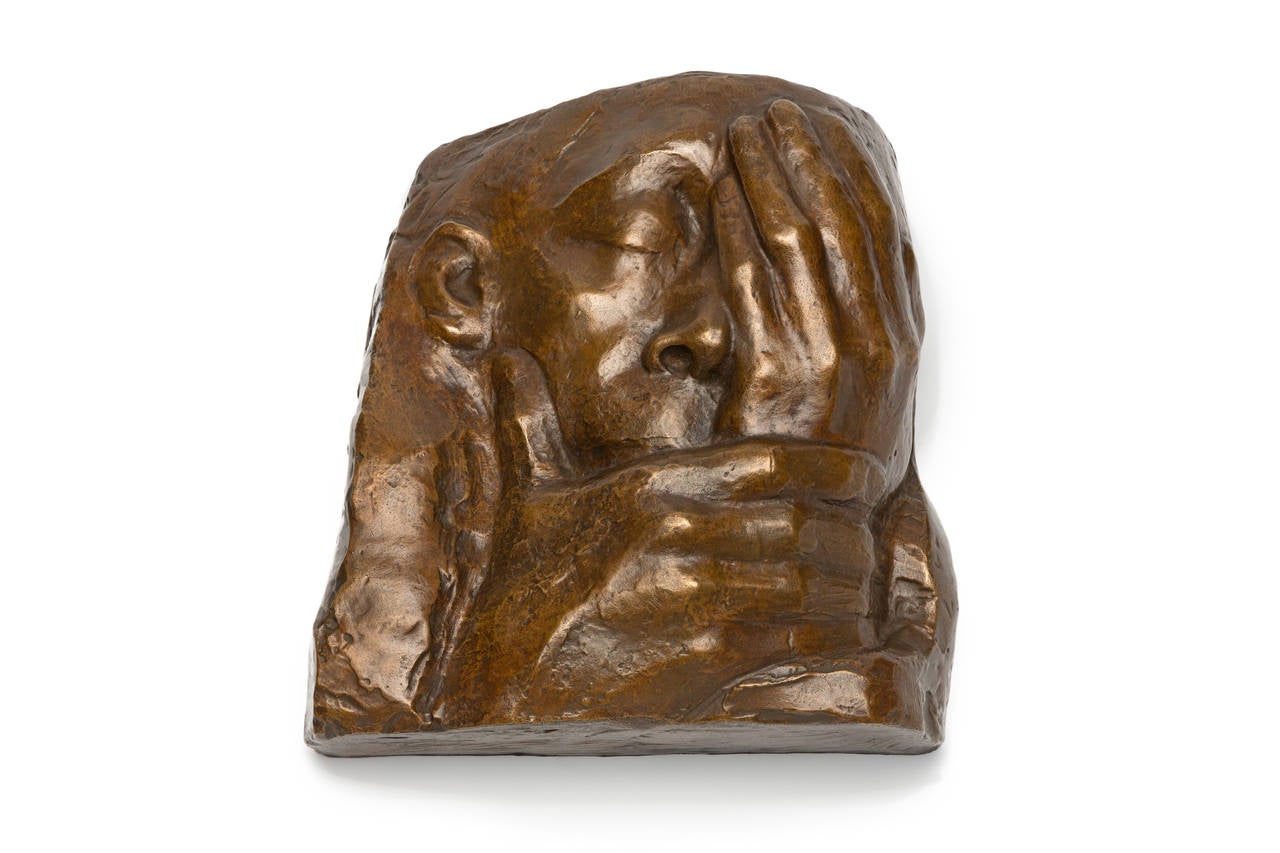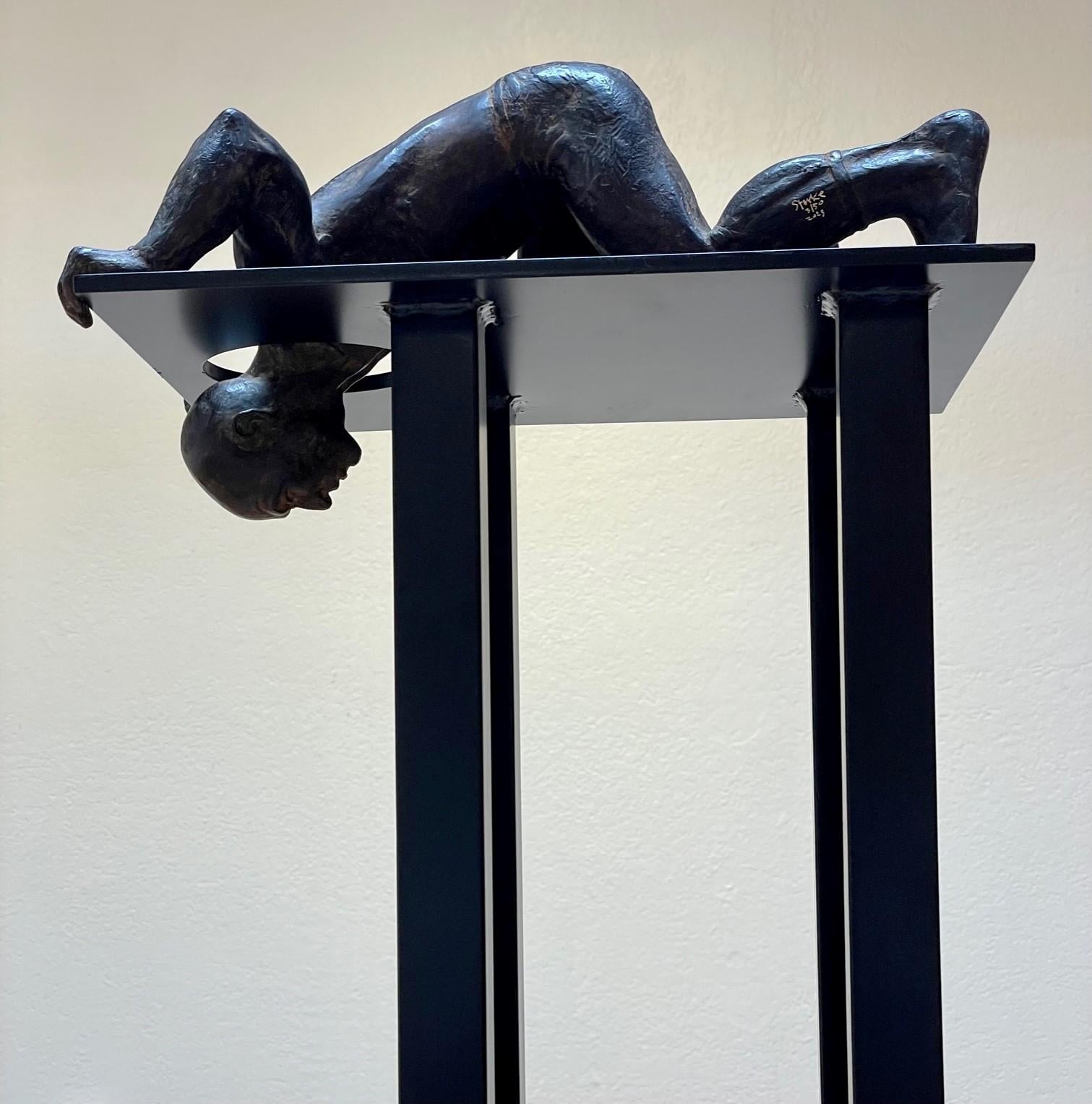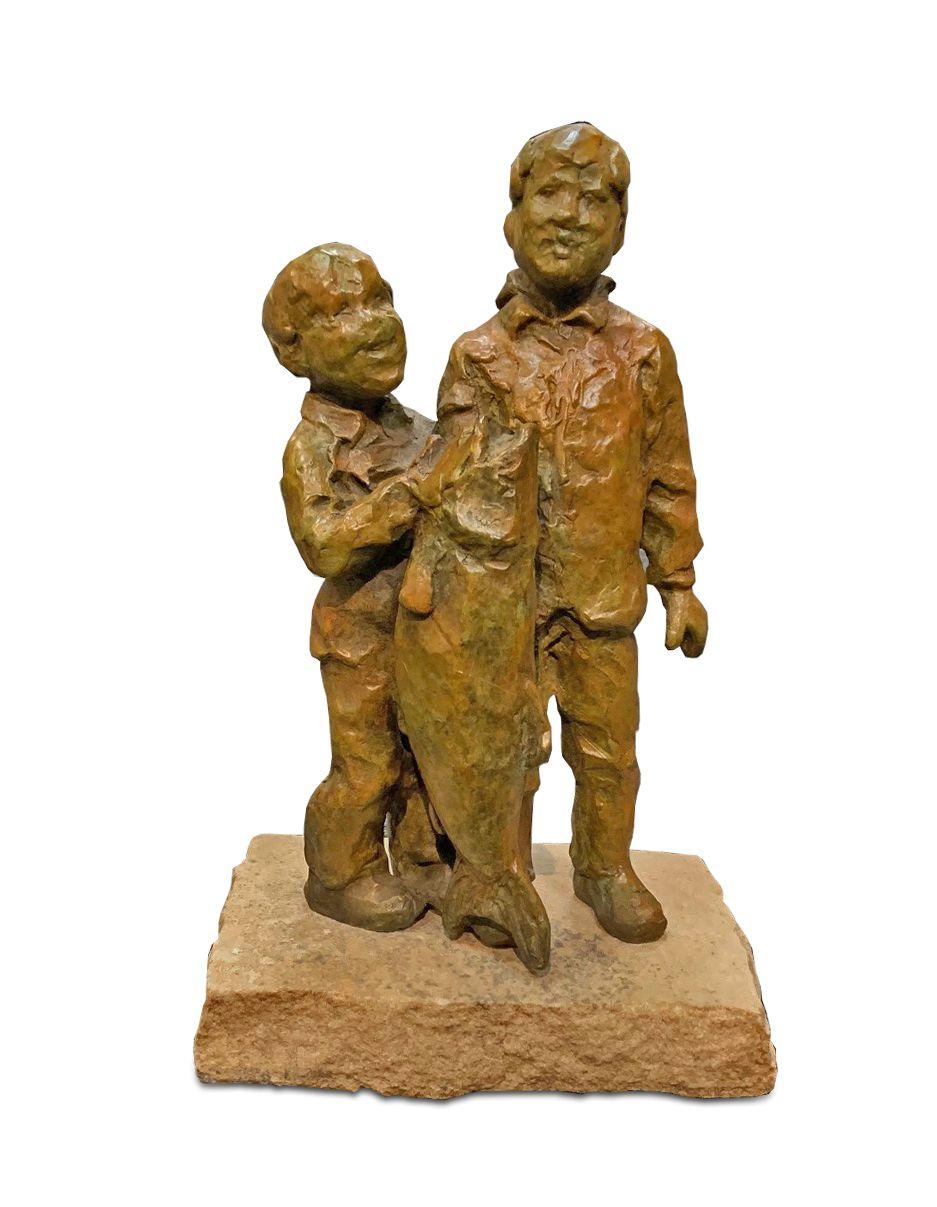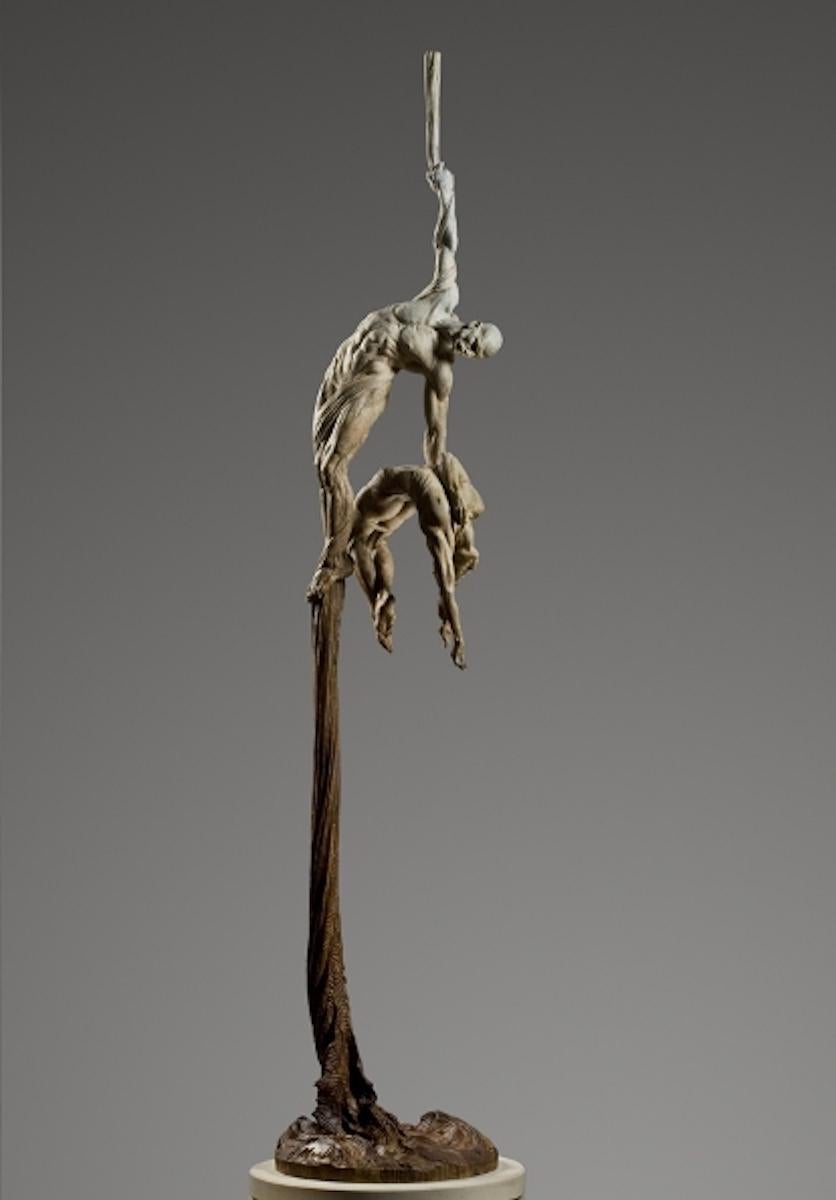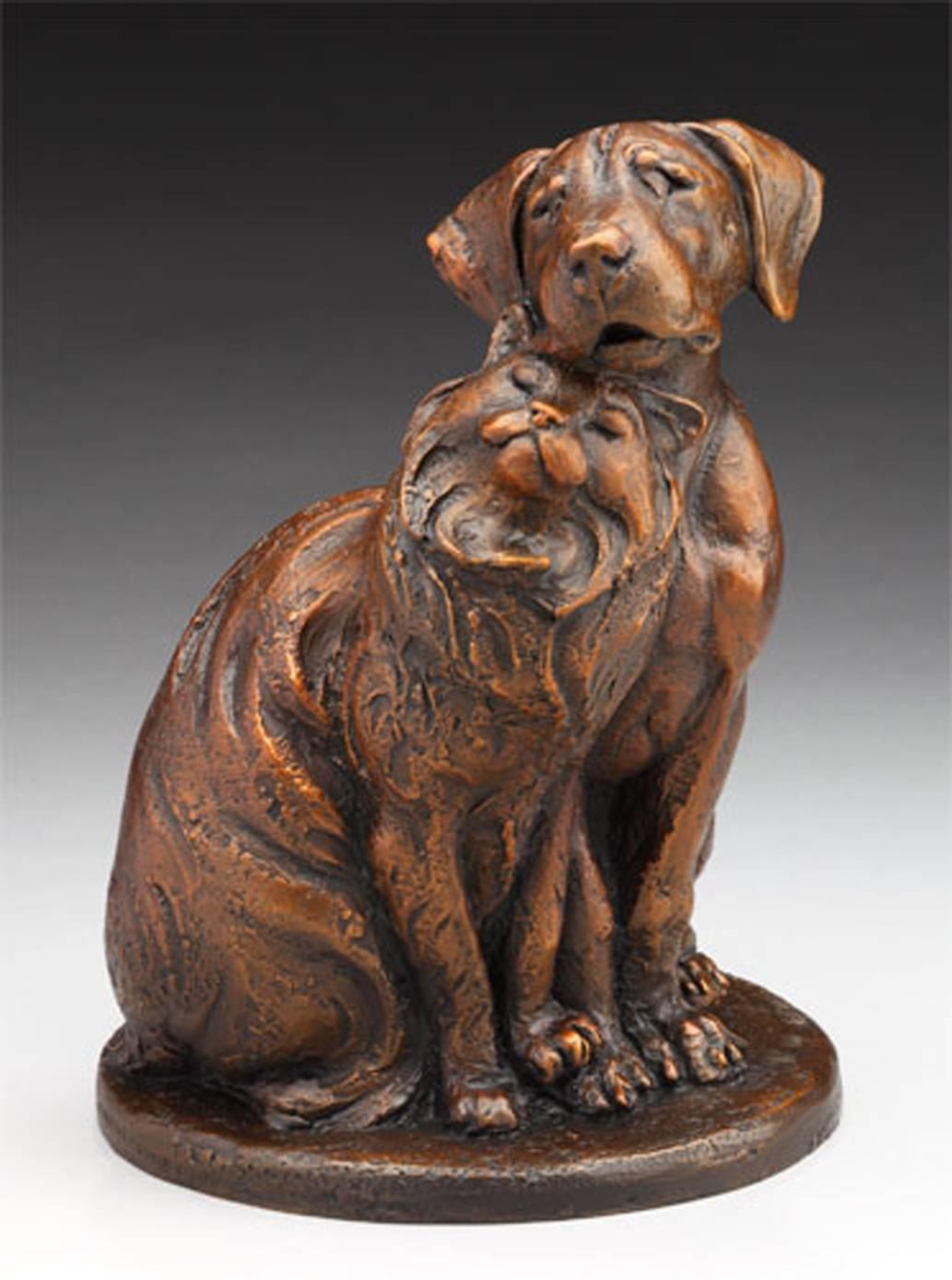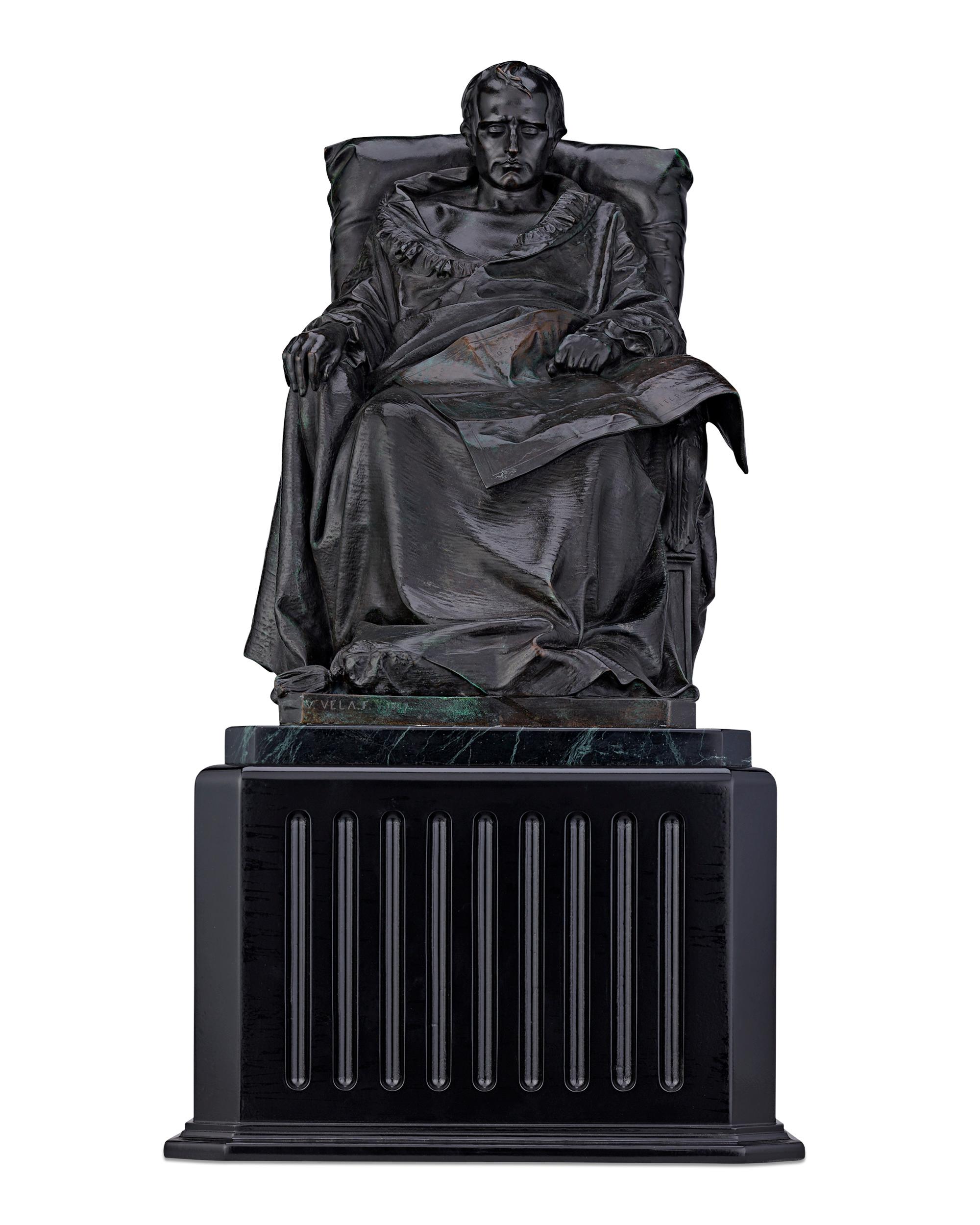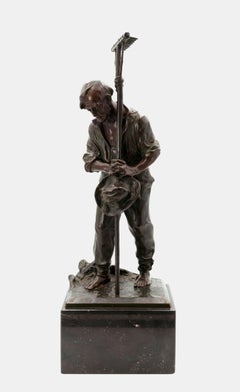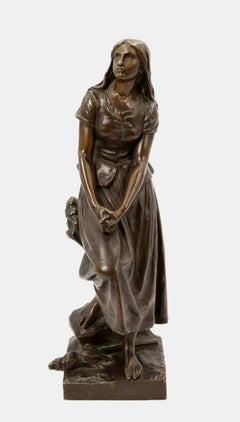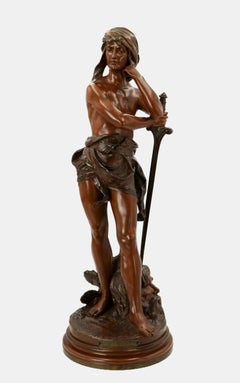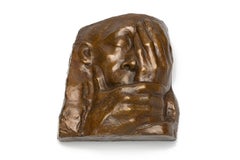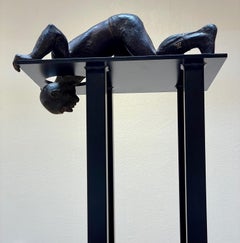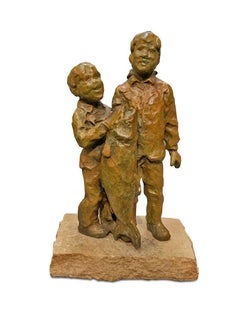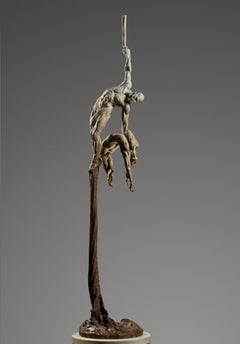Items Similar to Crusader with shield and mace / - Ready to strike -
Want more images or videos?
Request additional images or videos from the seller
1 of 14
Josef MoestCrusader with shield and mace / - Ready to strike -c. 1910
c. 1910
About the Item
Josef Moest (1873 Cologne - 1914 Rath), Crusader with shield and mace, around 1910. Bronze on a black marble pedestal (19 cm high). 57.5 cm (total height) x 21 cm (width) x 12 cm (depth), weight 24.8 kg. Incised signature “MOEST.” on the back of the base.
- Slightly worn in places, base minimally bumped, otherwise in excellent condition
- Ready to strike -
The crusader gazes resolutely over his raised shield at the enemy, his confident posture indicating that he will not retreat in the least, defending the terrain with his tightly wrapped mace. The armor, slightly damaged on the left shoulder, bears witness to battles already fought.
However, the stance is not only a secure position, but also a purposeful retreat that turns into a lunging movement. The already tensed muscles are masterfully visible under the chain mail, anticipating the powerful blow. By dynamizing the figure in this way, Josef Moest succeeds in depicting the battle on the basis of the individual figure without illustrating the battle as such. The impression of the crusader's presence beyond the historical distance is reinforced by the extremely realistic details. The finely woven chain mail as well as the leather straps give a convincing impression of the actual material.
The positioning on the high pedestal lends the figure a monumental quality, giving a moral impetus to the inner attitude depicted.
About the artist
As the son of the Cologne sculptor, restorer and collector of medieval sculptures, Richard Moest, Josef Moest was born with an interest in sculpture. After training under the cathedral sculptor Peter Fuchs, he studied sculpture under Syrius Eberle at the Munich Academy from 1897 to 1902. Moest then opened his own studio. He quickly made a name for himself as a sculptor. He created high-quality salon sculptures and was involved in numerous church decorations. In 1904, he co-founded the Cologne artists' association “Stil”. In 1908 he took part in the exhibition at the Munich Glaspalast and in 1909 in the Great Art Exhibition of the Düsseldorf Academy. Suffering from tuberculosis, Moest designed a Pietà for his own grave in 1912, when he was just 39 years old, before he died two years later.
GERMAN VERSION
Josef Moest (1873 Köln - 1914 Rath), Kreuzritter mit Schild und Streitkolben, um 1910. Bronze auf schwarzem Marmorpostament (19 cm Höhe). 57,5 cm (Gesamthöhe) x 21 cm (Breite) x 12 cm (Tiefe), Gewicht 24,8 kg. Ritzsignatur „MOEST.“ auf der Rückseite des Sockels.
- vereinzelt leicht betrieben, Sockel minimal bestoßen, ansonsten ausgezeichnet erhalten
- Zum Hieb bereit -
Der Kreuzritter blickt über das erhobene Schild hinweg entschlossen dem Feind entgegen, während der sichere Stand davon kündet, keinen Deut zurückzuweichen und das Terrain mit dem festumschlossenen Streitkolben zu verteidigen. Die an der linken Schulter etwas lädierte Rüstung zeugt von bereits ausgefochtenen Schlachten.
Die Körperhaltung ist aber nicht allein ein sicherer Stand, sie ist zugleich ein anvisierendes Zurückweichen, das in eine Ausholbewegung übergeht. Die bereits angespannte Muskulatur zeichnet sich auf meisterhafte Weise unter dem Kettenhemd ab und antizipiert den kraftvollen Schlag. Durch diese Dynamisierung der Figur gelingt es Josef Moest, das Kampfestgeschehen anhand der Einzelfigur zur Darstellung zu bringen, ohne den Kampf als solchen zu veranschaulichen. Dabei wird der Eindruck einer über die historische Distanz hinweg gegebenen Präsenz des Kreuzritters durch die äußerst realistisch ausgearbeiteten Details verstärkt. Das feinmaschige Kettenhemd vermittelt ebenso überzeugend wie die Lederriemen den Eindruck ihrer eigentlichen materiellen Beschaffenheit.
Die Positionierung auf dem hohen Postament verleiht der Figur etwas Denkmalhaftes, wodurch die dargestellte innere Haltung einen moralischen Impetus erhält.
zum Künstler
Als Sohn des Kölner Bildhauers, Restaurators und Sammlers mittelalterlicher Skulpturen, Richard Moest, war Josef Moest das Interesse für Bildhauerei in die Wiege gelegt. Nach einer Ausbildung bei dem Dombildhauer Peter Fuchs studierte er von 1897 bis 1902 bei Syrius Eberle Bildhauerei an der Münchener Akademie. Anschließend eröffnete Moest ein eigenes Atelier. Schnell machte er sich als Bildhauer einen Namen. Er schuf qualitätvolle Salonplastiken und war an zahlreichen Kirchenausstattungen beteiligt. 1904 war er Mitbegründer der Kölner Künstlervereinigung „Stil“. 1908 nahm er an der Ausstellung im Münchner Glaspalast teil und 1909 an der Großen Kunstausstellung der Düsseldorfer Akademie. An Tuberkulose leidend, entwarf Moest 1912, mit gerade einmal 39 Jahren, eine Pietà für sein eigenes Grab, bevor er zwei Jahre später verstarb.

About the Seller
5.0
Gold Seller
Premium sellers maintaining a 4.3+ rating and 24-hour response times
Established in 2014
1stDibs seller since 2023
16 sales on 1stDibs
Typical response time: 6 hours
- ShippingRetrieving quote...Shipping from: Berlin, Germany
- Return Policy
Authenticity Guarantee
In the unlikely event there’s an issue with an item’s authenticity, contact us within 1 year for a full refund. DetailsMoney-Back Guarantee
If your item is not as described, is damaged in transit, or does not arrive, contact us within 7 days for a full refund. Details24-Hour Cancellation
You have a 24-hour grace period in which to reconsider your purchase, with no questions asked.Vetted Professional Sellers
Our world-class sellers must adhere to strict standards for service and quality, maintaining the integrity of our listings.Price-Match Guarantee
If you find that a seller listed the same item for a lower price elsewhere, we’ll match it.Trusted Global Delivery
Our best-in-class carrier network provides specialized shipping options worldwide, including custom delivery.More From This Seller
View AllField worker with rake / - The Humility of the Farm Worker -
Located in Berlin, DE
Paul Ludwig Kowalczewski (1865 Mieltschin - 1910 Berlin), Field worker with rake, around 1900. Brown and brown-greenish patinated bronze with cast naturalistic plinth mounted on a wh...
Category
Early 1900s Realist Figurative Sculptures
Materials
Bronze
$1,468 Sale Price
20% Off
Reading Woman / - The golden glow of imagination -
By Albert-Ernest Carrier-Belleuse
Located in Berlin, DE
Albert-Ernest Carrier-Belleuse (1824 Anizy-le-Château - 1887 Sèvres), Reading Woman, around 1880. Polished bronze mounted on a cast base. 33 cm (total height) x 9 cm (length) x 9 cm ...
Category
1880s Realist Figurative Sculptures
Materials
Bronze
$2,203 Sale Price
20% Off
Joan of Arc / - The Liberating Power of Faith -
Located in Berlin, DE
Eugène Laurent (1832 Gray - 1898 Paris), Joan of Arc, around 1880. Brown patinated bronze on a cast rectangular plinth with tree trunk and distaff. 40 cm (height) x 15.5 cm (length) x 15.5 cm (depth), weight 6.1 kg. Signed “E.[ugène] Laurent.” on the plinth and inscribed “HZ” on the reverse.
- somewhat stained due to patina, traces of oxidation behind the distaff, slightly rubbed in places, overall still in very good condition for its age
- The Liberating Power of Faith -
At the age of 13, Jeanne, a peasant girl born in Lorraine around 1412, heard the voices of Saints Catherine and Margaret and the Archangel Michael telling her that she had been chosen to liberate France from English occupation. By 1428, Henry VI's troops had advanced to the Loire and besieged Orléans, a strategic city for the further conquest of France. Joan of Arc went to the exile of Charles VII and, with the king's consent, led the French army into battle against the besiegers. After four days of fighting, the English were defeated and Orléans was liberated. Other victorious battles followed, until in 1430 she fell into the hands of the enemy, who had her executed as a witch by the Inquisition. In May 1431, Joan of Arc was burned at Rouen.
After the final expulsion of the English, the "Maid of Orleans" was rehabilitated by the Church in 1456. She was finally canonized in 1920. By then, Joan of Arc had become a national heroine and the patron saint of France. After the French Revolution, the strengthening of the nation-state and the Franco-Prussian War of 1870-71, Joan of Arc was again venerated and depicted in numerous bronze statues.
Eugène Laurent depicts the young girl listening to the voices of the saints who reveal her destiny. With her eyes wide open, she gazes at the sky as if she were looking at the revealed future. Her hands are clasped in prayer, indicating her willingness to face her destiny. Leaning against a tree trunk, she treads with one foot on a raised stone, which, together with her upward gaze, gives her an upward movement that announces her higher mission. At the same time, however, she steps down from the stone to the earth, emphasizing her earthly mission, for which she has already taken the first step. In doing so, she steps over the discarded distaff, which refers to her "lower" origins and belongs to the life she has now left behind.
Laurent manages to capture the fateful emotion that makes us look at Joan of Arc in awe, even though she is a simple peasant girl. Even if the design is aimed at the overall impression, the artist has nevertheless worked out certain details, such as the tied waistcoat, very realistically and, in addition to the skin, has particularly depicted the material quality of the textiles.
About the artist
Eugène Laurent studied at the École des Beaux-Arts in Paris, where he won a prize in 1860. He then joined the studio of Jacques Antoine Theodore Coinchon. As a freelance artist, he supplied the Paris Salon with statues, portrait busts, and medallions from 1861 to 1893. He also created large sculptures such as the monument to Jacques Callot in Nancy (1877) and the statue of François Boucher at the Paris City Hall.
GERMAN VERSION
Eugène Laurent (1832 Gray - 1898 Paris), Jeanne d’Arc, um 1880. Braun patinierte Bronze auf mitgegossener rechteckiger Plinthe mit Baumstamm und Spinnrocken. 40 cm (Höhe) x 15,5 cm (Länge) x 15,5, cm (Tiefe), Gewicht 6,1 kg. Auf der Plinthe mit „E.[ugène] Laurent.“ signiert und rückseitig mit „HZ“ bezeichnet.
- patinabedingt etwas fleckig, Oxidationsspuren hinter dem Spinnrocken, stellenweise leicht berieben, insgesamt in einem altersgemäß noch sehr guten Zustand
- Die befreiende Kraft des Glaubens -
Als 13jähige vernahm das um 1412 in Lothringen geborene Bauernmädchen Jeanne Stimmen der Heiligen Katharina und Margarete und des Erzengels Michael, die ihr verkündeten, auserwählt zu sein, Frankreich von der englischen Besatzung zu befreien. 1428 waren die Truppen von Heinrich VI. bis zur Loire vorgerückt und belagerten die für eine Weitereroberung Frankreichs strategisch wichtige Stadt Orléans. Jeanne d’Arc begab sich ins Exil Karls VII. und führte mit der Einwilligung des Königs das französische Heer gegen die Belagerer ins Feld. Nach viertätiger Schlacht unterlagen die Engländer und Orléans war befreit. Es folgten weitere siegreiche Kämpfen bis sie 1430 in die Hände des Feindes fiel, der bei der Inquisition ihre Hinrichtung als Hexe erwirkte. Im Mai 1431 wurde Jeanne d’Arc in Rouen verbrannt.
Im Anschluss an die endgültige Vertreibung der Engländer wurde die „Jungfrau von Orléans“ 1456 von der Kirche rehabilitiert. 1920 erfolgte schließlich ihre Heiligsprechung. Inzwischen galt Jeanne d’Arc als Nationalheldin und Schutzpatronin Frankreichs. In der Nachfolge der Französischen Revolution, dem Erstarken der Nationalstaatlichkeit und dem Deutsch-Französischen Krieg von 1870/71 erfuhr Jeanne d‘Art eine neue Verehrung und wurde in zahlreichen Bronzestatuen dargestellt.
Eugène Laurent zeigt das junge Mädchen wie sie die Stimmen der Heiligen vernimmt, die ihr das von der Vorsehung bestimmte Schicksal offenbaren. Mit weit geöffneten Augen blickt sie gen Himmel als ob sie die offenbarte Zukunft schauen würde. Dabei hat sie die Hände in Gebetshaltung geschlossen, was zugleich vom Willen kündet, sich ihrem Schicksal zu stellen. An einen Baumstamm gelehnt, tritt sie mit dem einen Fuß auf einen erhöhten Stein, was ihr – zusammen mit dem aufwärts gerichteten Blick – eine von ihrer höheren Mission kündende Aufwärtsbewegung verleiht. Zugleich tritt sie aber auch von dem Stein auf die Erde herab, wodurch ihre irdische Mission hervorgehoben wird, zu der sie bereits den ersten Schritt getan hat. Dabei steigt sie über den abgelegten Spinnrocken hinweg, der auf ihre ‚niedere‘ Herkunft verweist und zum nun abgelegten Leben gehört.
Laurent gelingt es, die schicksalhafte Ergriffenheit zur Darstellung zu bringen, die uns Jeanne d‘Arc, obwohl sie ein einfaches Bauernmädchen ist, ehrfürchtig betrachten lässt. Auch wenn die Gestaltung auf den Gesamteindruck zielt, hat der Künstler doch einzelne Details, wie die zugebundene Weste, äußerst realitätsnah herausgearbeitet und neben der Haut insbesondere die stoffliche Qualität der Textilien zur Darstellung gebracht.
zum Künstler
Eugène Laurent studierte an der Pariser École des Beaux-Arts und wurde 1860 von der Akademie mit einem Preis ausgezeichnet. Anschließend trat er in das Atelier Jacques Antoine Theodore Coinchon ein. Als freischaffender Künstler beschickte er von 1861 bis 1893 den Pariser Salon mit Statuen, Porträtbüsten und Medaillons. Zudem schuf er Großplastiken wie das Denkmal Jacques Callots in Nancy (1877) und die Statue...
Category
1890s Realist Figurative Sculptures
Materials
Bronze
$1,101 Sale Price
20% Off
The Victorious David / - The melancholy of the radiant hero -
Located in Berlin, DE
Henri Honoré Plé (1853 Paris - 1922 Paris), The Victorious David, around 1890. Red-brown and brown patinated bronze with terrain plinth mounted on a round base. 62 cm (total height) ...
Category
1890s Realist Figurative Sculptures
Materials
Bronze
$3,855 Sale Price
20% Off
The Victorious David / - The melancholy of the radiant hero -
Located in Berlin, DE
Henri Honoré Plé (1853 Paris - 1922 Paris), The Victorious David, around1890. Red-brown and brown patinated bronze with terrain plinth mounted on a round base. 42 cm (total height) x...
Category
1890s Realist Figurative Sculptures
Materials
Bronze
$1,744 Sale Price
20% Off
Young Roman / - Youthful Sprezzatura -
Located in Berlin, DE
Fritz Heinemann (1864 Altena - 1932 Berlin), Young Roman, 1892. Brownish patinated bronze on a cast round plinth, mounted on a red marble base (8.5 cm high), total height 36 cm, dime...
Category
1890s Realist Figurative Sculptures
Materials
Bronze
$826 Sale Price
20% Off
You May Also Like
Klage um Ernst Barlach ( Memorial for Ernst Barlach )
By Käthe Kollwitz
Located in Berlin, DE
Impressive Bronze Relief by Käthe Kollwitz ( 1867-1945, Germany ). Created 1938 in memory of her friend Ernst Barlach.
Bronze brown patinated. On the left side signed: Kollwitz.
He...
Category
1930s Realist Figurative Sculptures
Materials
Bronze
"The Seeker, " Sculpture
By Bill Starke
Located in Denver, CO
Bill Starke's "The Seeker" is a limited edition (#3/50), bronze sculpture created by Bill Starke depicting a male figure peering down through a small opening beneath him.
About th...
Category
2010s Realist Figurative Sculptures
Materials
Bronze, Metal
Big Fish Story
By Jane DeDecker
Located in Greenwich, CT
Sculpture of two boys displaying a sizeable catch.
Edition of 50
Category
1990s Realist Figurative Sculptures
Materials
Bronze
Orpheus Ascending
By Richard MacDonald
Located in Laguna Beach, CA
Some works of art are exploratory; they ask questions, but offer no answers. Some are the distillation of a lifetime of experience, and the answers they give cannot easily be translated into words. Richard MacDonald’s latest mythological sculpture, “Orpheus Ascending...
Category
21st Century and Contemporary Realist Figurative Sculptures
Materials
Bronze
Price Upon Request
Puppy Love
By Louise Peterson
Located in Greenwich, CT
"This piece was commissioned by the American Animal Hospital Association as an award for the best veterinary hospital in animal care. After a lot of ha...
Category
Realist Figurative Sculptures
Materials
Bronze
THE LAST DAYS OF NAPOLÉON BY
Located in New Orleans, LA
This highly evocative bronze by Vincenzo Vela captures the deposed Emperor Napoléon on his deathbed, holding a map of Europe and lost in thought about what might have been. Remarkable among most portrayals of the exiled leader, this highly detailed sculpture depicts Napoléon at his most vulnerable. Nonetheless, Vela perfectly captures his still-heroic bearing, which imparts to this work a monumental quality and quiet dignity. The mate to this figure is the colossal marble at the Musée du Château de Malmaison, which was shown at the Paris Salon of 1867.
The founder of the verismo movement in Italy, Vela was one of the great exponents of realism in sculpture. Born in Ligornetto, Switzerland in 1820, he studied under celebrated sculptor, Benedetto Cacciatori. He was also influenced both by the work of Tuscan sculptor Lorenzo Bartolini, who seamlessly combined neoclassicism with naturalism and the romantic painting of Francesco Hayez...
Category
19th Century Realist Figurative Sculptures
Materials
Marble, Bronze
